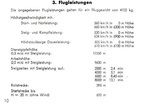davparlr
Senior Master Sergeant
All you have said is good. I know that top speed in only a certain part of the equation for fighting. The info you have provided is probably more important. Unfortunately we often have top speed and little else in order to do an analysis (especially my data).wmaxt said:With respect to D-Day and the surrender escort, that is undoubtedly true as the P-38s area because as you put it "Easy Identification". I don't have the back up but he flew P-38s on other occasions to.
Dave, The L model could go faster than 414mph, there are several reports including a AAF test, that its top speed at ~25,000ft was as high as 443mph. I only have a Lockheed graph at this time so I can't nail it down as fact (I require at least two different and reliable sources before I'll accept this kind of stuff as fact). Here are a couple of things to consider:
1. Absolute top speed is only an issue in level flight in a relatively straight line ie. persuing/running. Even using 414mph the only enemy fighter that exceeded that was the Bf-109K with special fuel. The P-51 was only faster (using 414mph) between 20,000ft and 27,000ft at all other altitudes the P-38 was as fast or faster.
2. After two turns speed was running in the 250mph to 325mph range anyway with energy retention and acceleration being much more important, the P-38 excelled at both. These speeds also allowed the P-38 to use its maneuvering flaps letting it turn with about anything out there.
3. In a bounce/escape dive the level top speed doesn't enter into the equation.
4. Finally the maximum top speed is only valid at one altitude/condition so in reality it was only a bench mark and even that was dependant on aircraft condition.
wmaxt
I noted in my research that the P-38 was faster than most of the enemy planes until late in the war.
You have certainly convinced me that the P-38 was a formidable fighting machine in the right hands. And the fact that the pilots had confidence in it also makes a good point. Pilots do not have confidence in aircraft that doesn't give them a fighting chance.
The comment in the fighter study about it not being a "modern" fighter is strange and smells of a bias input.


